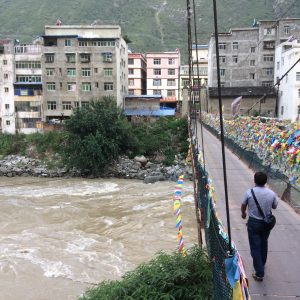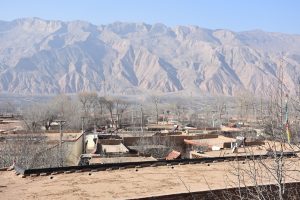50. Towards a New Language of the Global Language Crisis
This post is also available in: Catalan
Gerald Roche
Senior Research Fellow
La Trobe University, Australia
Another Global Crisis
While our attention remains consumed by the global crisis of the COVID pandemic, we are also living in the midst of another, slow-motion global crisis. This crisis sees millions of people around the world stigmatized, marginalized, excluded, and discriminated against, and even killed because of the languages they speak, sign, and use. This crisis affects Australia, where I live, and also Tibet, where I have lived and conducted research. This global language crisis means that at least half of the languages used today will most likely no longer be used by the end of the century.
The town of Guza in eastern Tibet, where many Tibetans speak the Gochang language.
Like the Manegacha language discussed below, Gochang is one of Tibet’s unrecognized languages.
This crisis is fundamentally political: it is an issue of social justice. In any given country, and within our world at large, different languages and the people who use them receive unequal respect, resources, power, and attention. It is these inequalities, this linguistic injustice, that drives the global language crisis.
In order to escape the worlds of suffering created by these inequalities, people are everywhere ‘choosing’ to learn dominant languages in order to achieve economic and social mobility. They are also ‘choosing’ to stop using languages that are denied equal recognition and support. This unjust world of forced choice, gross inequality and suffering is the architecture of the slow-motion global language crisis.
However, if we look at dominant representations of the global language crisis in the popular imagination and in academia, we could be forgiven for failing to notice that it is a crisis of social justice on a global scale. We could be forgiven for seeing something else altogether.
Beyond Biology
For the past thirty years, our dominant way of thinking about the global language crisis has used models borrowed from conservation biology and the environmental movement. This approach, known as ‘endangerment linguistics,’ has mapped global linguistic diversity, created vast databases of linguistic data, raised public awareness about endangered languages, and developed new methods to teach and learn languages.
But despite its success as an academic field, endangerment linguistics has failed as a discourse: as a way of thinking and talking about a problem, and a way of perceiving and acting on the world. It has, for example, promoted problematic analogies between human languages and biological species. But more importantly, it has veiled the social injustice that lies at the heart of the global language crisis.
If we want to address the global language crisis, we need to stop talking about endangered languages, and thinking about this human problem through the lens of biology and ecology. However, it’s not enough to simply point out how endangerment discourses are problematic. In addition to critique, we need a positive project to bring a paradigm shift to our view on the global language crisis. Most of all, we need new language to help us think about and address this problem.
In other fields of social justice, we already recognize that how we talk impacts how we think and how we act on the world. We use gender neutral pronouns. We capitalize Indigenous. We refer to ‘undocumented migrants’ rather than ‘illegal immigrants’. We avoid slurs and language that belittles and demeans. It’s time we applied the principles of just language to the global language crisis.
Towards a New Language of the Global Language Crisis
We need new language to talk about the global language crisis, to help us see it as a social justice issue. But what does that language look like? I think the following four points should be central to our new language of global language injustice.
Oppression, not endangerment. Oppression, not endangerment, lies at the heart of the global language crisis. Languages, and the people who use and identify with them, are dominated, deprived, marginalized, stigmatized, excluded, and subordinated. These languages are not endangered. The distinction between oppression and endangerment is the distinction between an approach that is explicitly political, and one which consistently works to depoliticize the problem. Furthermore, while endangerment is a feature of languages and populations, oppression is a feature of systems, structures, and relationships. Talking about language oppression centers the political and the relational; endangerment blames the victim. While endangerment highlights symptoms, oppression focuses on the causes of the underlying problems that need to be solved.
Languages don’t oppress themselves. A failure to identify unjust political relations, and a tendency to blame victims, are entrenched in the language of endangerment discourses. These problems are often seen in the use of passive language. Languages are said to decline, vanish, die, and disappear. Populations dwindle, recede or get depleted. When active language is used, it often blames the community: languages are forgotten, lost or abandoned. Or, blame is deferred by referring to false protagonists that are described as causing endangerment, such as modernization, urbanization, migration, or globalization (none of these processes ever seems to endanger dominant languages). In order to center relations of inequality and injustice, we need use active language that places the onus on the perpetrators and aims to identify the institutions and individuals that create and maintain structures of injustice.
People, not languages. Endangerment discourses focus on languages: how languages are lost, how many are endangered, how we can record or revitalize them, what it means when a language dies, what the value of language maintenance is, and so on. A social justice approach focuses on people. Speakers and signers of a language are oppressed. Communities are excluded. People are stigmatized and suffer. To constantly remind ourselves that language oppression is a human tragedy, and not an abstract decline in knowledge or diversity, we must constantly work to center people. The global language crisis is, in truth, a global crisis of human suffering.
Disadvantage, not deficit. Endangerment discourses often portray languages as suffering from deficits. Languages ‘decline’ because they are not written, or not taught in schools, or lack prestige or vitality, or have failed to expand into new domains, or because speakers have negative attitudes. Languages are seen as failing to withstand the challenges posed by false protagonists like globalization. Instead of focusing on language deficits, a social justice approach centers how speakers of oppressed languages are harmed and disadvantaged by inequalities. Languages don’t wither because they lack the tools to survive in the modern world, people stop using them because injustice connects those languages to social disadvantage, pain, suffering, and trauma.
Endangered and Oppressed Languages in Tibet
Let me contrast these two ways of speaking about this issue, with an example from my own research. I originally began working with endangerment discourses, but now use a social justice approach. My work focuses on the languages of Tibet. Here, I will introduce my research twice: once using an endangerment discourse, and again using a social justice discourse.
Endangerment discourse: Endangered languages in Tibet. Tibet is linguistically diverse. Many of its languages are endangered. Under the impacts of rapid urbanization and unprecedented development, these languages are losing speakers. Different languages in Tibet are endangered to different degrees. While Tibetan is threatened by the national language (Putonghua, or Modern Standard Mandarin), other languages are much closer to extinction. Soon, some of them may vanish completely.
One such language is Manegacha, spoken by about 8,000 Tibetans on the northeast Tibetan Plateau. This language is currently spoken in four villages, but many families in these communities are abandoning it and shifting to Tibetan instead. Furthermore, the language has failed to expand into many new domains, such as digital media. If this situation continues, this unique aspect of human heritage and the knowledge it contains will be lost.
Overlooking the village of Tojya Wodkor, where the majority of people currently speak Manegacha,
one of Tibet’s unrecognized languages.
Social justice discourse: Language oppression in Tibet. Tibetans in China speak and sign several languages. National policy promotes the national standard language, known as Putonghua or Modern Standard Mandarin, at the expense of all other languages in Tibet. Policy also unofficially creates a distinction between recognized minority languages, like Tibetan, and unrecognized languages, which the state refuses to acknowledge. While recognized languages are under-developed and deprived relative to Putonghua, they do receive limited state support. Meanwhile, unrecognized languages are slated for elimination and denied all support. Often, the state achieves its goals through measures beyond language policy, by refusing to support languages in the course of highly disruptive state-building processes, such as urbanization and development.
Manegacha is one of Tibet’s unrecognized languages. The 8,000 Tibetans who speak it are denied the right to use their language in education, employment, media, healthcare, and other crucial contexts. In order to provide better life chances in their children, and to spare them from facing linguistic discrimination, many Manegacha speakers are making the difficult decision to not transmit their language to their children. Without significant political change, this program of elimination and the hardship it causes will continue.
These two discourses provide very different pictures of the same situation. The social justice framing identifies the perpetrator, puts the onus for change on them and demonstrates how injustice negatively impacts victims, while also emphasizing the possibility for positive change. In contrast, the endangerment discourse presents a world that is abstract, impersonal and mechanical, where certain processes seem inevitable, and where languages are lost but nobody suffers.
Shifting our Language
In my research, I have been working hard to shift my language. I am constantly trying to center social justice and eschew endangerment discourses in how I talk about languages in Tibet. I think this is the best way to do justice to the people I work with and write for, the best way to represent their interests, and to repay the generosity they have shown me.
But shifting language isn’t easy. Endangerment discourses have predominated as long as I have been thinking about these problems. And although they have been repeatedly critiqued, they still haven’t been shifted from their position of prominence. Often, I find endangerment discourses speaking through me – choosing my words, and shaping the way I portray the world.
If we want to help build a new language for addressing the global language crisis, one thing we can all do is hold ourselves and each other accountable for our language. This doesn’t mean we should attack and blame one another. Instead, we should endeavor to work together so that the language of social justice is always at the tip of our tongue, always at the ready to shape the way we describe, think about, and act within the global language crisis.


